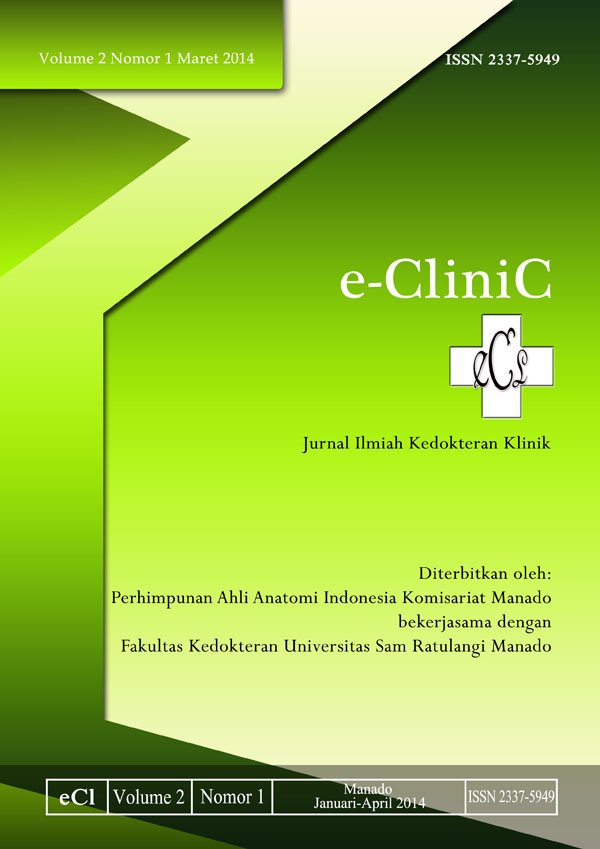HASIL AUTOPSI SEBAB KEMATIAN MENDADAK TAK TERDUGA DI BAGIAN FORENSIK BLU RSUP. PROF. DR. R. D. KANDOU MANADO TAHUN 2010-2012
DOI:
https://doi.org/10.35790/ecl.v2i1.4397Abstract
Abstract: According to WHO, sudden death is the death that occurred 24 hours after the symptom arise, but in some forensic cases, most of the death cases occurred in matter of minutes or might be seconds as the first symptom arise. Sudden deaths increase along the aging. Sudden deaths that caused by disease are often bring suspicion thus they need to be proven by doing the medicolegal autopsy, to which the result will be revealed. This research aims to determine the results of the autopsy cause of sudden unexpected death on forensic BLU department of RSUP. Prof. Dr. R. D. Kandou Manado in 2010-2012. This research is using retrospective descriptive method. Research population is all the alleged victims of sudden deaths in BLU. RSUP. Prof. Dr. R. D. Kandou Manado in 2010-2012. Sample is taken by total sampling method. There are 12 cases of sudden deaths, 4 of them are not qualified to be taken as sample because of incomplete data. The total of sudden deaths based on gender are 7 cases of Males (87.5%), and 1 case of Female (12.5%). Sudden death occurs more frequently in adult with 3 cases (37.5%) on 41-59 years old range. 3 cases on heart disease (37.5%), 2 cases on lung disease (25%), 1 case on lung cancer (12.5%), and the other 2 are unknown reason (25%). From this study, it is concluded that sudden deaths are more common to male in 41-59 years old range, and the most common cause of sudden death is cardiovascular system
Keywords: Sudden deaths, autopsy, cardiovascular system.
Â
Â
Abstrak: Kematian mendadak menurut WHO adalah kematian yang terjadi pada 24 jam sejak gejala-gejala timbul, namun pada kasus-kasus forensik, sebagian besar kematian terjadi dalam hitungan menit atau bahkan detik sejala gejala pertama timbul. Kejadian kematian mendadak meningkat seiring dengan bertambahnya usia. Kematian mendadak yang disebabkan oleh penyakit, sering mendatangkan kecurigaan sehingga perlu dibuktikan dengan dilakukannya autopsi medikolegal, yang hasilnya dapat menunjukkan sebab kematian tersebut. Penelitian ini bertujuan untuk mengetahui hasil autopsi sebab kematian mendadak tak terduga di Bagian Ilmu Kedokteran Forensik BLU. RSUP. Prof. Dr. R. D. Kandou Manado tahun 2010-2012. Penelitian ini merupakan penelitian deskriptif retrospektif. Populasi penelitian adalah seluruh korban dugaan mati mendadak di BLU. RSUP. Prof. Dr. R. D. Kandou Manado tahun 2010-2012. Pengambilan sampel menggunakan teknik total sampling. Terdapat sebanyak 12 kasus kematian mendadak, 4 diantaranya tidak memenuhi syarat untuk dijadikan sampel karena datanya yang tidak lengkap. Jumlah kematian mendadak berdasarkan jenis kelamin yaitu laki-laki sebanyak 7 kasus (87.5%) dan perempuan 1 kasus (12.5%). Kematian mendadak lebih banyak terjadi pada kelompok dewasa yaitu dengan usia 41-59 tahun sebanyak 3 kasus (37.5%). Kematian mendadak akibat penyakit jantung sebanyak 3 kasus (37.5%), penyakit paru sebanyak 2 kasus (25%), penyakit lainnya (tidak diketahui sebabnya) 2 kasus (25%), dan kanker paru hanya terdapat 1 kasus (12.5%). Dari penelitian ini disimpulkan bahwa kematian mendadak terjadi lebih sering pada laki-laki, serta paling banyak dialami pada usia 41-59 tahun. Penyebab tersering kematian mendadak diakibatkan oleh sistem kardiovaskular.
Kata Kunci: Kematian mendadak, autopsi, sistem kardiovaskular.
Downloads
How to Cite
Issue
Section
License
COPYRIGHT
Authors who publish with this journal agree to the following terms:
Authors hold their copyright and grant this journal the privilege of first publication, with the work simultaneously licensed under a Creative Commons Attribution License that permits others to impart the work with an acknowledgment of the work's origin and initial publication by this journal.
Authors can enter into separate or additional contractual arrangements for the non-exclusive distribution of the journal's published version of the work (for example, post it to an institutional repository or publish it in a book), with an acknowledgment of its underlying publication in this journal.
Authors are permitted and encouraged to post their work online (for example, in institutional repositories or on their website) as it can lead to productive exchanges, as well as earlier and greater citation of the published work (See The Effect of Open Access).







